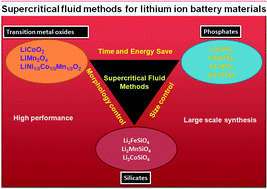Supercritical fluid methods for synthesizing cathode materials towards lithium ion battery applications
Abstract
Lithium ion battery materials improve the current technology to store electrical energy for the creation of green environment. The synthesis of lithium ion battery materials is crucial for energy applications in mobile electronic devices to plug-in hybrid electric vehicles. This review summarizes the recent progress made to synthesize lithium ion battery materials via supercritical fluid methods, and particularly, its application towards the synthesis of layered transition metal oxides, spinel structured cathodes, lithium metal phosphates, lithium metal silicates and lithium metal fluorophosphates. The structure, particle size, morphology and electrochemical properties of cathode materials are discussed. From the perspective of material synthesis, supercritical fluid methods are economical and have several advantages such as phase purity, morphology control and size tuning down to 5 nm, which would significantly impact the performance of lithium ion batteries.


 Please wait while we load your content...
Please wait while we load your content...